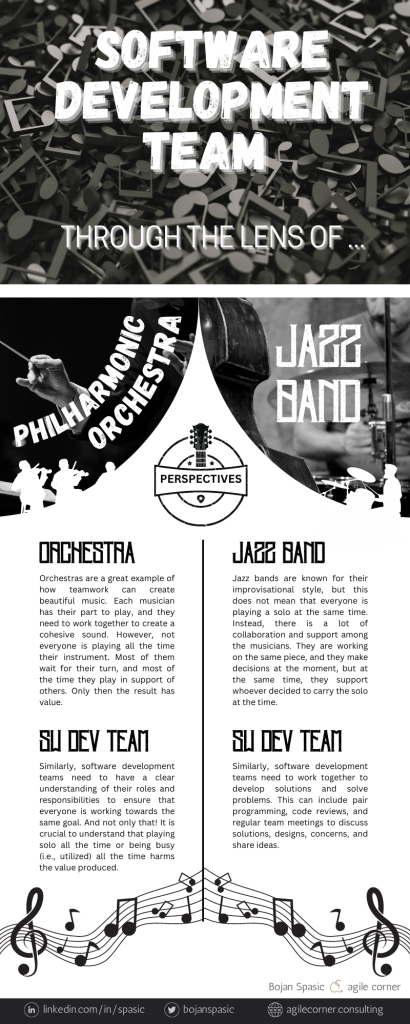
Software Development Team Through a Philharmonic Orchestra Lens
Orchestras are a great example of how teamwork can create beautiful music. Each musician has their part to play, and they need to work together to create a cohesive sound. However, not everyone is playing all the time their instrument. Most of them wait for their turn, and most of the time they play in support of others. Only then the result has value.
Similarly, software development teams need to have a clear understanding of their roles and responsibilities to ensure that everyone is working towards the same goal. And not only that! It is crucial to understand that playing solo all the time or being busy (i.e., utilized) all the time harms the value produced.
Software Development Team is a Jazz Band
Jazz bands are known for their improvisational style, but this does not mean that everyone is playing a solo at the same time. Instead, there is a lot of collaboration and support among the musicians. They are working on the same piece, and they make decisions at the moment, but at the same time, they support whoever decided to carry the solo at the time.
Similarly, software development teams need to work together to develop solutions and solve problems. This can include pair programming, code reviews, and regular team meetings to discuss solutions, designs, concerns, and share ideas.
The Pitfalls of Isolation
Working in isolation can be detrimental to both the team and the quality of the results. When team members work in isolation, they can miss out on valuable information and feedback from other team members. This lack of communication can lead to misunderstandings, mistakes, and delays. Moreover, working in isolation can lead to a lack of motivation and engagement, as team members do not feel connected to the project or the team.
I discussed several perspectives on such pitfalls in my earlier posts:
- Cross-functional Software Development Team
- Most Probable Reasons for SW Development Team Misunderstandings
- Is Your Team a Team or Something Else
- The Effects of Continuous Brainstorming
- Four Basic Teamwork Perspectives
What now?
To ensure that software development teams function at their best, it is essential to:
- Understand the negative effects of insisting on fully utilizing team members: Provide support on the highest-value work for the team at the time.
- Encourage collaboration: Team members should work together to solve problems and develop solutions, including pair programming and regular team meetings.
- Foster a culture of communication: Regular organic exchanges (in contrast to transactional scheduled ones), code reviews, and continuous feedback sessions can help ensure that team members are aware of progress and can offer valuable feedback.
- Avoid working in isolation: Team members should avoid working in isolation to ensure that they feel connected to the project and the team.
It is common knowledge that software development is a dynamic field that requires collaboration, communication, and teamwork. Drawing parallels with orchestras and jazz bands, we can see how these principles can be applied to software development teams. By providing constant support to the team results, encouraging collaboration, fostering a culture of communication, and avoiding working in isolation, software development teams can deliver high-quality products and enjoy a fulfilling and productive working experience.
